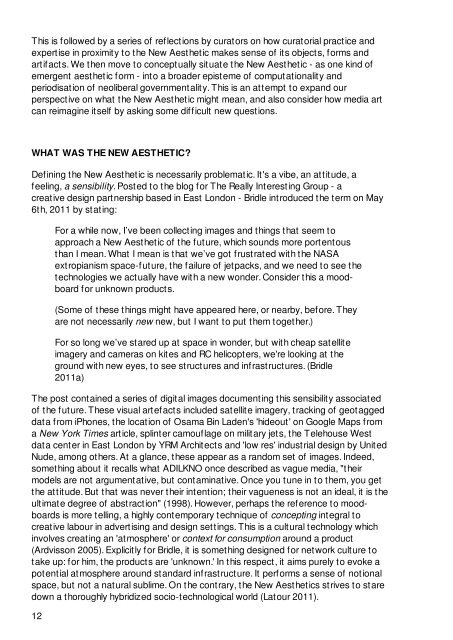New Aesthetic New Anxieties - Institute for the Unstable Media
New Aesthetic New Anxieties - Institute for the Unstable Media
New Aesthetic New Anxieties - Institute for the Unstable Media
You also want an ePaper? Increase the reach of your titles
YUMPU automatically turns print PDFs into web optimized ePapers that Google loves.
This is followed by a series of reflections by curators on how curatorial practice andexpertise in proximity to <strong>the</strong> <strong>New</strong> <strong>Aes<strong>the</strong>tic</strong> makes sense of its objects, <strong>for</strong>ms andartifacts. We <strong>the</strong>n move to conceptually situate <strong>the</strong> <strong>New</strong> <strong>Aes<strong>the</strong>tic</strong> - as one kind ofemergent aes<strong>the</strong>tic <strong>for</strong>m - into a broader episteme of computationality andperiodisation of neoliberal governmentality. This is an attempt to expand ourperspective on what <strong>the</strong> <strong>New</strong> <strong>Aes<strong>the</strong>tic</strong> might mean, and also consider how media artcan reimagine itself by asking some difficult new questions.WHAT WAS THE NEW AESTHETIC?Defining <strong>the</strong> <strong>New</strong> <strong>Aes<strong>the</strong>tic</strong> is necessarily problematic. It's a vibe, an attitude, afeeling, a sensibility. Posted to <strong>the</strong> blog <strong>for</strong> The Really Interesting Group - acreative design partnership based in East London - Bridle introduced <strong>the</strong> term on May6th, 2011 by stating:For a while now, I’ve been collecting images and things that seem toapproach a <strong>New</strong> <strong>Aes<strong>the</strong>tic</strong> of <strong>the</strong> future, which sounds more portentousthan I mean. What I mean is that we’ve got frustrated with <strong>the</strong> NASAextropianism space-future, <strong>the</strong> failure of jetpacks, and we need to see <strong>the</strong>technologies we actually have with a new wonder. Consider this a moodboard<strong>for</strong> unknown products.(Some of <strong>the</strong>se things might have appeared here, or nearby, be<strong>for</strong>e. Theyare not necessarily new new, but I want to put <strong>the</strong>m toge<strong>the</strong>r.)For so long we’ve stared up at space in wonder, but with cheap satelliteimagery and cameras on kites and RC helicopters, we're looking at <strong>the</strong>ground with new eyes, to see structures and infrastructures. (Bridle2011a)The post contained a series of digital images documenting this sensibility associatedof <strong>the</strong> future. These visual artefacts included satellite imagery, tracking of geotaggeddata from iPhones, <strong>the</strong> location of Osama Bin Laden's 'hideout' on Google Maps froma <strong>New</strong> York Times article, splinter camouflage on military jets, <strong>the</strong> Telehouse Westdata center in East London by YRM Architects and 'low res' industrial design by UnitedNude, among o<strong>the</strong>rs. At a glance, <strong>the</strong>se appear as a random set of images. Indeed,something about it recalls what ADILKNO once described as vague media, "<strong>the</strong>irmodels are not argumentative, but contaminative. Once you tune in to <strong>the</strong>m, you get<strong>the</strong> attitude. But that was never <strong>the</strong>ir intention; <strong>the</strong>ir vagueness is not an ideal, it is <strong>the</strong>ultimate degree of abstraction" (1998). However, perhaps <strong>the</strong> reference to moodboardsis more telling, a highly contemporary technique of concepting integral tocreative labour in advertising and design settings. This is a cultural technology whichinvolves creating an 'atmosphere' or context <strong>for</strong> consumption around a product(Ardvisson 2005). Explicitly <strong>for</strong> Bridle, it is something designed <strong>for</strong> network culture totake up: <strong>for</strong> him, <strong>the</strong> products are 'unknown.' In this respect, it aims purely to evoke apotential atmosphere around standard infrastructure. It per<strong>for</strong>ms a sense of notionalspace, but not a natural sublime. On <strong>the</strong> contrary, <strong>the</strong> <strong>New</strong> <strong>Aes<strong>the</strong>tic</strong>s strives to staredown a thoroughly hybridized socio-technological world (Latour 2011).12








